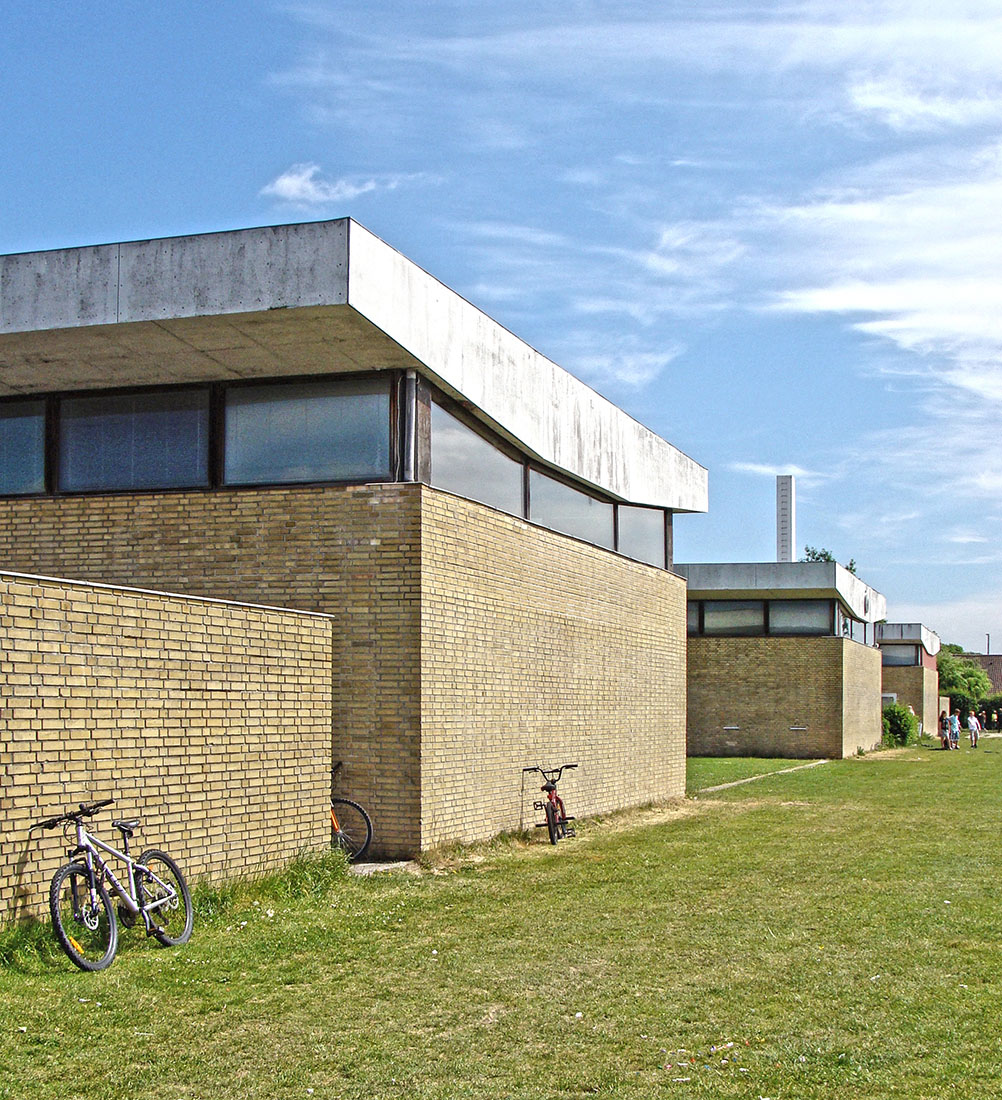 |
 |
 |
 |

Nyager Elementary School
Nyagervange 14
Rødovre, Copenhagen
1959 - 1964
After
winning the limited architectural competition, Arne Jacobsen built the
Nyager Elementary School for the community of Rødovre,
a suburb of Copenhagen. The construction works for this building started in 1959, and the school was completed in 1964.
One of the main design goals of Arne Jacobsen was to arrive at a layout which would allow the creation of "a sensation of intimacy and clarity".
The concept of this building is somehow related to the earlier Munkegård school, as it becomes obvious in the drawings of the classroom section.
The whole Project is structured by the rhythm of a two-metre modulation, which was imposed as a design criteria. The complex consists
of a long building volume, und several pavillon-like structures, which are connected to each other. To the west side, there are located the science classrooms
and the administrative area. The classrooms are arranged on both sides of the corridor, which leads to the administrative wing.
The classroom zone opens onto two playground courtyards, which are destined for the children of different maturity. The smaller of the two courtyards
is located to the north. This north courtyard is bounded by a block of service rooms and an opaque wall. The other courtyard features the gymnasium,
an indoor pool, the changing rooms and the sauna on one side. The sportfields are located to the south of the complex, while there is a landscaped area
to the east, and the prter's lodge to the north-east. The administrative wing accomodates additional functions required in the programme, such as
the head heacher's office, staff rooms, the school offices, the medical area, including rooms for a child psychologist and a dentist, the library,
the rooms for evening classes and a small nursery school. To receive abundant daylight from two directions, the classrooms face ast and west.
At a lower level, there is a large window looking onto the lateral courtyard, while at a higher level there is a continuous strip window, that is almost
a roof-light in the upper part of the same façade. The building is made of load-bearing brick walls, running the length of the corridor and supporting
pre-cast concrete beams of variable sections. The shapes of the roof is a well known feature of this building. The roof construction consists
of a system of horizontal beams and wooden panels with a coating of bitumen on the exterior. In the classrooms, the low ceilings are suspended from the beams.
The interior walls are made of painted brickwork, while the carpentry consists of teak wood and the ceilings were made of acoustic aluminium.
a suburb of Copenhagen. The construction works for this building started in 1959, and the school was completed in 1964.
One of the main design goals of Arne Jacobsen was to arrive at a layout which would allow the creation of "a sensation of intimacy and clarity".
The concept of this building is somehow related to the earlier Munkegård school, as it becomes obvious in the drawings of the classroom section.
The whole Project is structured by the rhythm of a two-metre modulation, which was imposed as a design criteria. The complex consists
of a long building volume, und several pavillon-like structures, which are connected to each other. To the west side, there are located the science classrooms
and the administrative area. The classrooms are arranged on both sides of the corridor, which leads to the administrative wing.
The classroom zone opens onto two playground courtyards, which are destined for the children of different maturity. The smaller of the two courtyards
is located to the north. This north courtyard is bounded by a block of service rooms and an opaque wall. The other courtyard features the gymnasium,
an indoor pool, the changing rooms and the sauna on one side. The sportfields are located to the south of the complex, while there is a landscaped area
to the east, and the prter's lodge to the north-east. The administrative wing accomodates additional functions required in the programme, such as
the head heacher's office, staff rooms, the school offices, the medical area, including rooms for a child psychologist and a dentist, the library,
the rooms for evening classes and a small nursery school. To receive abundant daylight from two directions, the classrooms face ast and west.
At a lower level, there is a large window looking onto the lateral courtyard, while at a higher level there is a continuous strip window, that is almost
a roof-light in the upper part of the same façade. The building is made of load-bearing brick walls, running the length of the corridor and supporting
pre-cast concrete beams of variable sections. The shapes of the roof is a well known feature of this building. The roof construction consists
of a system of horizontal beams and wooden panels with a coating of bitumen on the exterior. In the classrooms, the low ceilings are suspended from the beams.
The interior walls are made of painted brickwork, while the carpentry consists of teak wood and the ceilings were made of acoustic aluminium.
